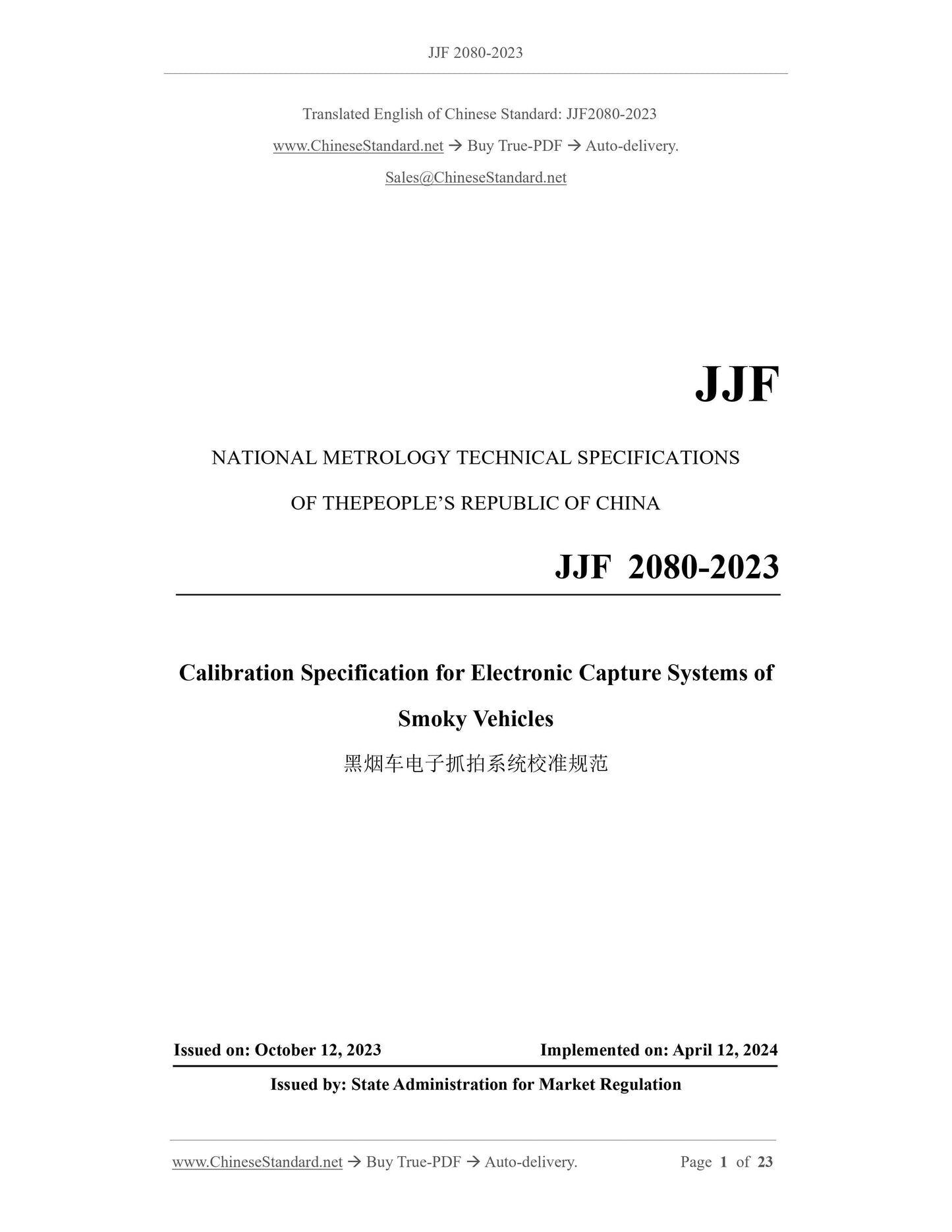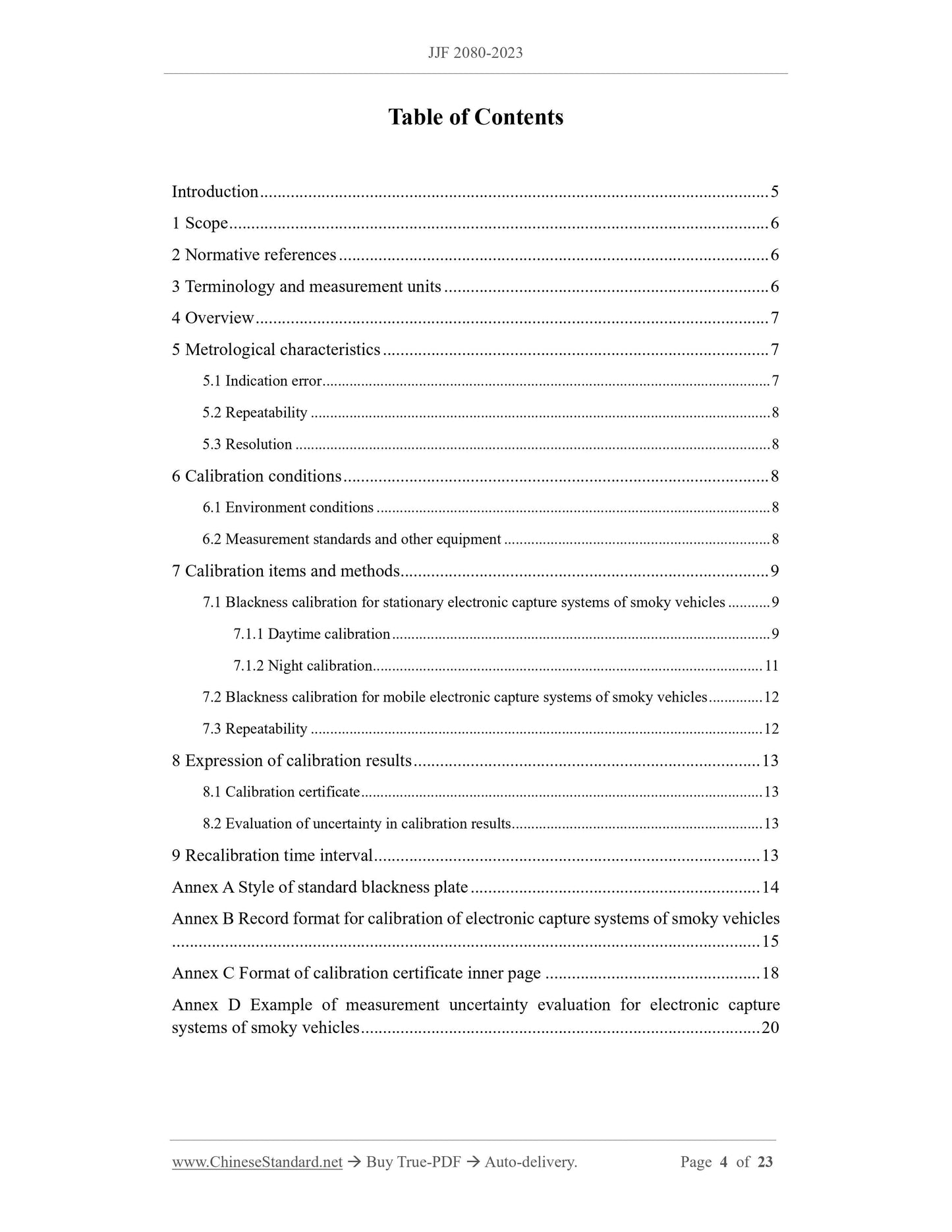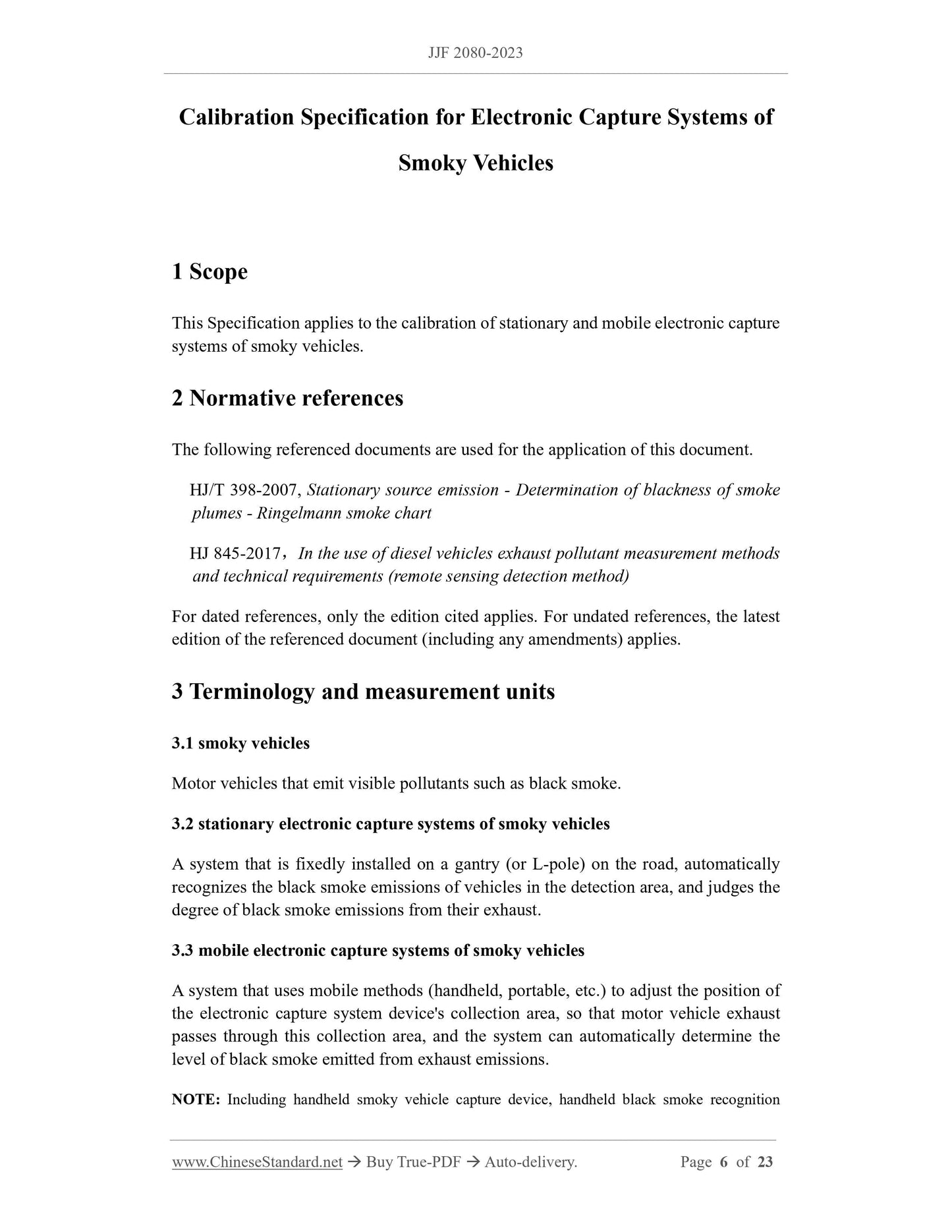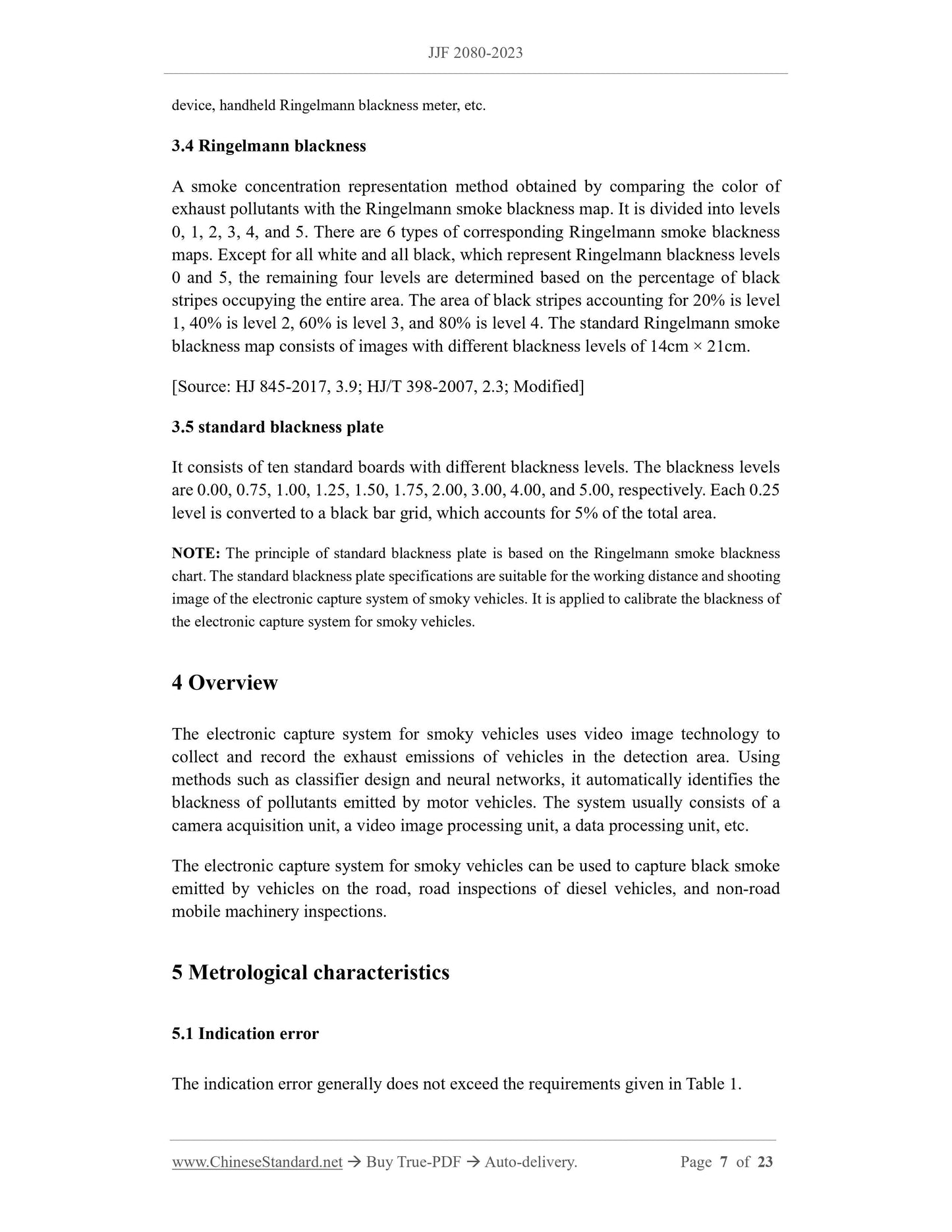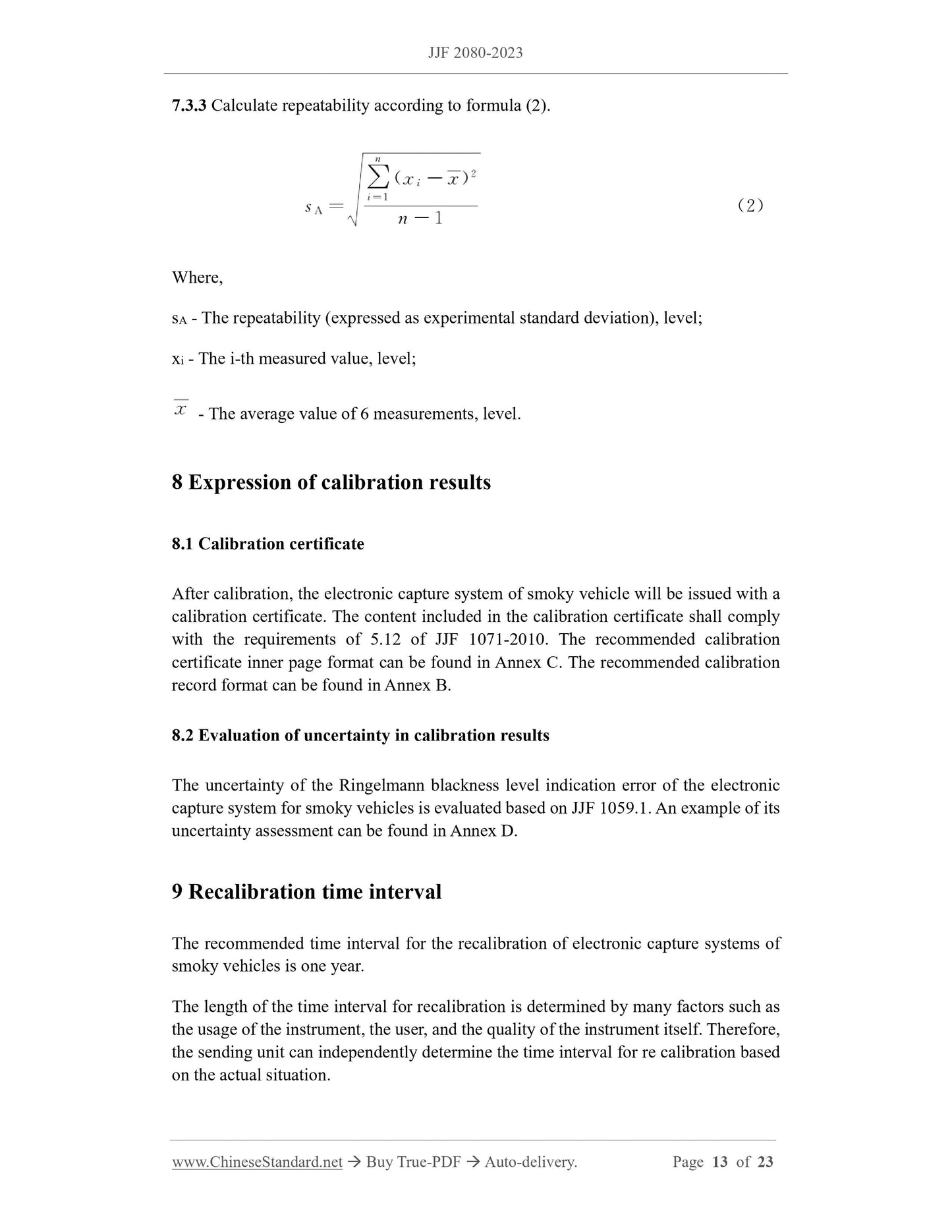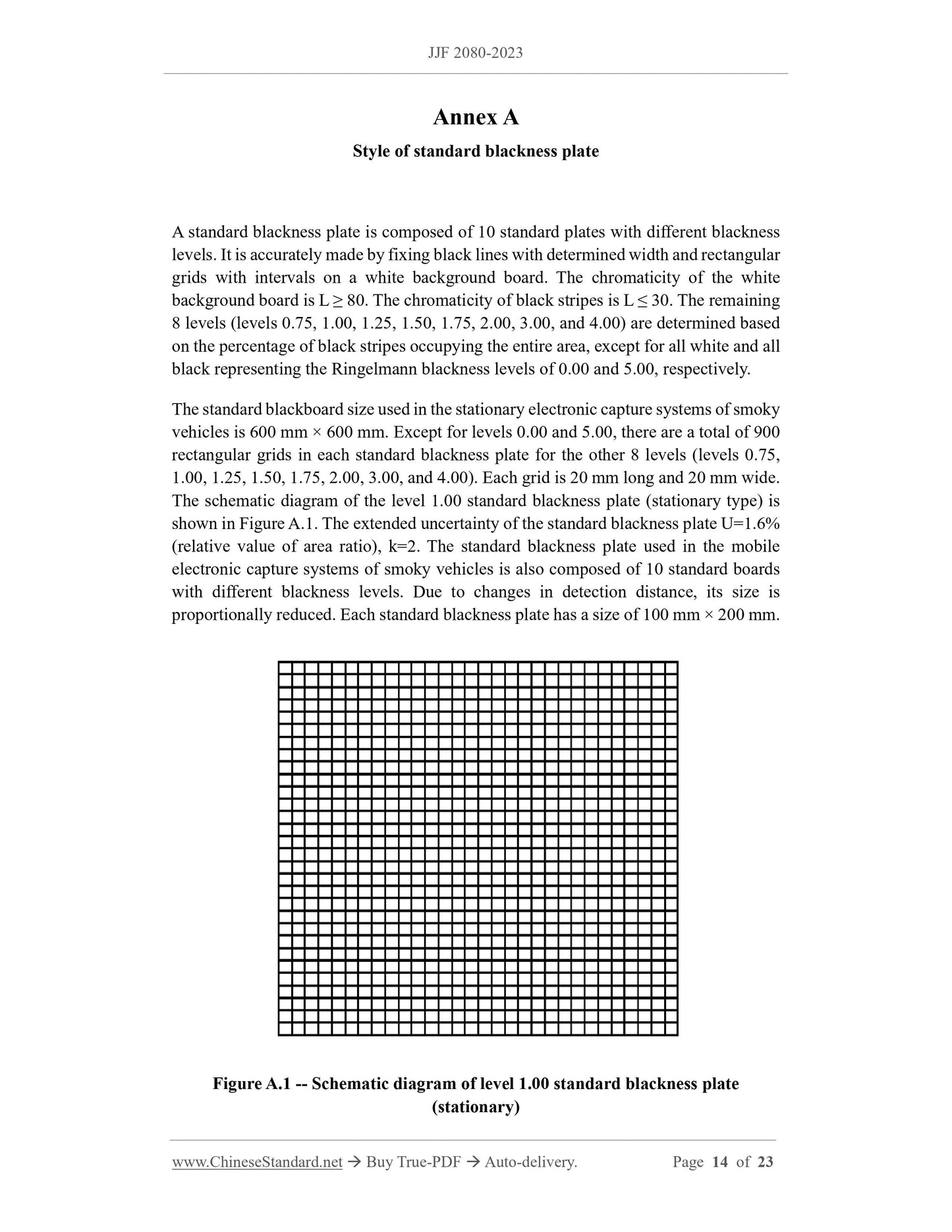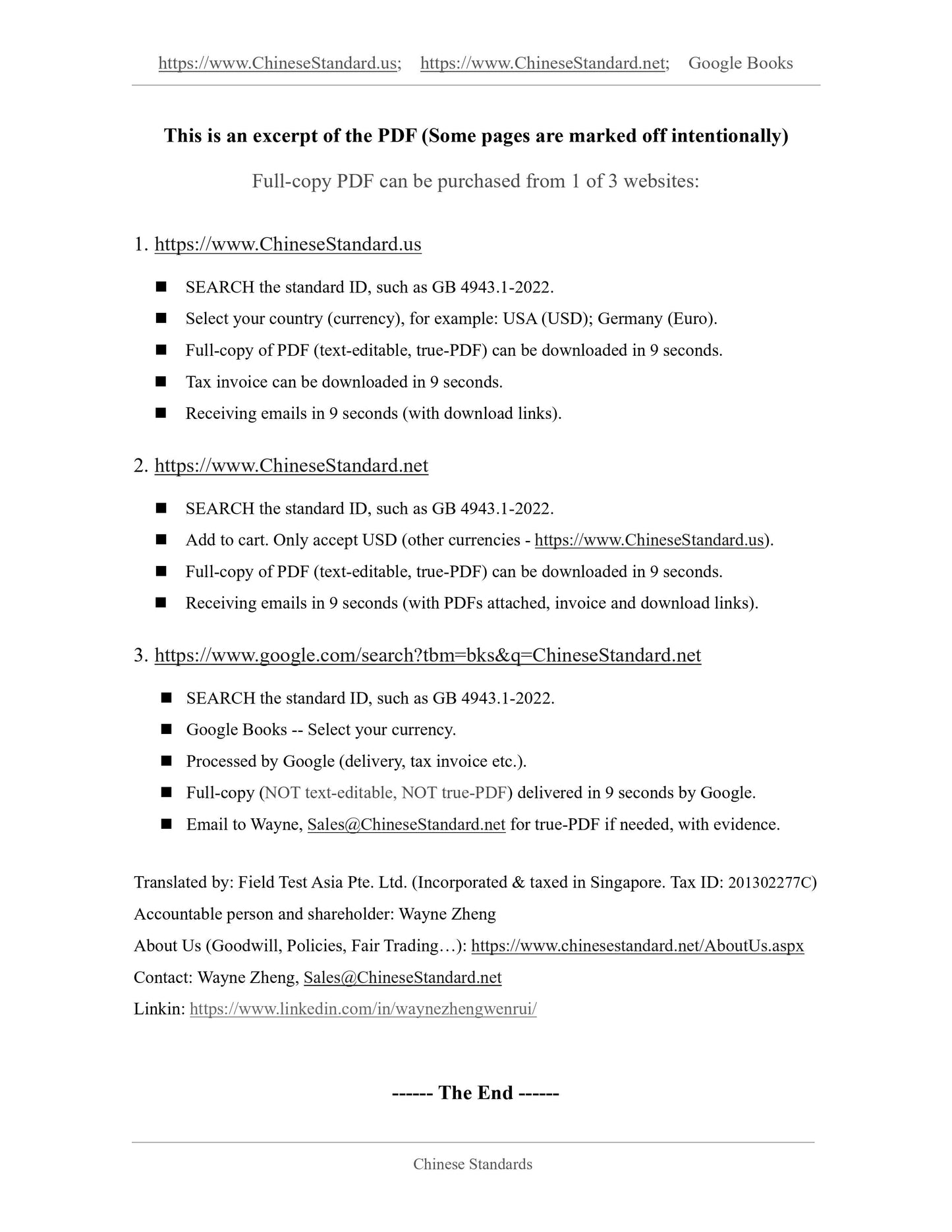1
/
of
7
www.ChineseStandard.us -- Field Test Asia Pte. Ltd.
JJF 2080-2023 English PDF
JJF 2080-2023 English PDF
Regular price
$320.00
Regular price
Sale price
$320.00
Unit price
/
per
Shipping calculated at checkout.
Couldn't load pickup availability
JJF 2080-2023: Calibration Specification for Electronic Capture Systems of Smoky Vehicles
Delivery: 9 seconds. Download (& Email) true-PDF + Invoice.
Get Quotation: Click JJF 2080-2023 (Self-service in 1-minute)
Historical versions (Master-website): JJF 2080-2023
Preview True-PDF (Reload/Scroll-down if blank)
JJF 2080-2023
JJF
NATIONAL METROLOGY TECHNICAL SPECIFICATIONS
OF THEPEOPLE’S REPUBLIC OF CHINA
Calibration Specification for Electronic Capture Systems of
Smoky Vehicles
ISSUED ON: OCTOBER 12, 2023
IMPLEMENTED ON: APRIL 12, 2024
Issued by: State Administration for Market Regulation
Table of Contents
Introduction ... 5
1 Scope ... 6
2 Normative references ... 6
3 Terminology and measurement units ... 6
4 Overview ... 7
5 Metrological characteristics ... 7
5.1 Indication error ... 7
5.2 Repeatability ... 8
5.3 Resolution ... 8
6 Calibration conditions ... 8
6.1 Environment conditions ... 8
6.2 Measurement standards and other equipment ... 8
7 Calibration items and methods ... 9
7.1 Blackness calibration for stationary electronic capture systems of smoky vehicles ... 9
7.1.1 Daytime calibration ... 9
7.1.2 Night calibration ... 11
7.2 Blackness calibration for mobile electronic capture systems of smoky vehicles ... 12
7.3 Repeatability ... 12
8 Expression of calibration results ... 13
8.1 Calibration certificate ... 13
8.2 Evaluation of uncertainty in calibration results ... 13
9 Recalibration time interval ... 13
Annex A Style of standard blackness plate ... 14
Annex B Record format for calibration of electronic capture systems of smoky vehicles
... 15
Annex C Format of calibration certificate inner page ... 18
Annex D Example of measurement uncertainty evaluation for electronic capture
systems of smoky vehicles ... 20
Calibration Specification for Electronic Capture Systems of
Smoky Vehicles
1 Scope
This Specification applies to the calibration of stationary and mobile electronic capture
systems of smoky vehicles.
2 Normative references
The following referenced documents are used for the application of this document.
HJ/T 398-2007, Stationary source emission - Determination of blackness of smoke
plumes - Ringelmann smoke chart
HJ 845-2017, In the use of diesel vehicles exhaust pollutant measurement methods
and technical requirements (remote sensing detection method)
For dated references, only the edition cited applies. For undated references, the latest
edition of the referenced document (including any amendments) applies.
3 Terminology and measurement units
3.1 smoky vehicles
Motor vehicles that emit visible pollutants such as black smoke.
3.2 stationary electronic capture systems of smoky vehicles
A system that is fixedly installed on a gantry (or L-pole) on the road, automatically
recognizes the black smoke emissions of vehicles in the detection area, and judges the
degree of black smoke emissions from their exhaust.
3.3 mobile electronic capture systems of smoky vehicles
A system that uses mobile methods (handheld, portable, etc.) to adjust the position of
the electronic capture system device's collection area, so that motor vehicle exhaust
passes through this collection area, and the system can automatically determine the
level of black smoke emitted from exhaust emissions.
NOTE: Including handheld smoky vehicle capture device, handheld black smoke recognition
device, handheld Ringelmann blackness meter, etc.
3.4 Ringelmann blackness
A smoke concentration representation method obtained by comparing the color of
exhaust pollutants with the Ringelmann smoke blackness map. It is divided into levels
0, 1, 2, 3, 4, and 5. There are 6 types of corresponding Ringelmann smoke blackness
maps. Except for all white and all black, which represent Ringelmann blackness levels
0 and 5, the remaining four levels are determined based on the percentage of black
stripes occupying the entire area. The area of black stripes accounting for 20% is level
1, 40% is level 2, 60% is level 3, and 80% is level 4. The standard Ringelmann smoke
blackness map consists of images with different blackness levels of 14cm × 21cm.
[Source: HJ 845-2017, 3.9; HJ/T 398-2007, 2.3; Modified]
3.5 standard blackness plate
It consists of ten standard boards with different blackness levels. The blackness levels
are 0.00, 0.75, 1.00, 1.25, 1.50, 1.75, 2.00, 3.00, 4.00, and 5.00, respectively. Each 0.25
level is converted to a black bar grid, which accounts for 5% of the total area.
NOTE: The principle of standard blackness plate is based on the Ringelmann smoke blackness
chart. The standard blackness plate specifications are suitable for the working distance and shooting
image of the electronic capture system of smoky vehicles. It is applied to calibrate the blackness of
the electronic capture system for smoky vehicles.
4 Overview
The electronic capture system for smoky vehicles uses video image technology to
collect and record the exhaust emissions of vehicles in the detection area. Using
methods such as classifier design and neural networks, it automatically identifies the
blackness of pollutants emitted by motor vehicles. The system usually consists of a
camera acquisition unit, a video image processing unit, a data processing unit, etc.
The electronic capture system for smoky vehicles can be used to capture black smoke
emitted by vehicles on the road, road inspections of diesel vehicles, and non-road
mobile machinery inspections.
5 Metrological characteristics
5.1 Indication error
The indication error generally does not exceed the requirements given in Table 1.
7.3.3 Calculate repeatability according to formula (2).
Where,
sA - The repeatability (expressed as experimental standard deviation), level;
xi - The i-th measured value, level;
- The average value of 6 measurements, level.
8 Expression of calibration results
8.1 Calibration certificate
After calibration, the electronic capture system of smoky vehicle will be issued with a
calibration certificate. The content included in the calibration certificate shall comply
with the requirements of 5.12 of JJF 1071-2010. The recommended calibration
certificate inner page format can be found in Annex C. The recommended calibration
record format can be found in Annex B.
8.2 Evaluation of uncertainty in calibration results
The uncertainty of the Ringelmann blackness level indication error of the electronic
capture system for smoky vehicles is evaluated based on JJF 1059.1. An example of its
uncertainty assessment can be found in Annex D.
9 Recalibration time interval
The recommended time interval for the recalibration of electronic capture systems of
smoky vehicles is one year.
The length of the time interval for recalibration is determined by many factors such as
the usage of the instrument, the user, and the quality of the instrument itself. Therefore,
the sending unit can independently determine the time interval for re calibration based
on the actual situation.
Annex A
Style of standard blackness plate
A standard blackness plate is composed of 10 standard plates with different blackness
levels. It is accurately made by fixing black lines with determined width and rectangular
grids with intervals on a white background board. The chromaticity of the white
background board is L ≥ 80. The chromaticity of black stripes is L ≤ 30. The remaining
8 levels (levels 0.75, 1.00, 1.25, 1.50, 1.75, 2.00, 3.00, and 4.00) are determined based
on the percentage of black stripes occupying the entire area, except for all white and all
black representing the Ringelmann blackness levels of 0.00 and 5.00, respectively.
The standard blackboard size used in the stationary electronic capture systems of smoky
vehicles is 600 mm × 600 mm. Except for levels 0.00 and 5.00, there are a total of 900
rectangular grids in each standard blackness plate for the other 8 levels (levels 0.75,
1.00, 1.25, 1.50, 1.75, 2.00, 3.00, and 4.00). Each grid is 20 mm long and 20 mm wide.
The schematic diagram of the level 1.00 standard blackness plate (stationary type) is
shown in Figure A.1. The extended uncertainty of the standard blackness plate U=1.6%
(relative value of area ratio), k=2. The standard blackness plate used in the mobile
electronic capture systems of smoky vehicles is also composed of 10 standard boards
with different blackness levels. Due to changes in detection distance, its size is
proportionally reduced. Each standard blackness plate has a size of 100 mm × 200 mm.
Figure A.1 -- Schematic diagram of level 1.00 standard blackness plate
(stationary)
JJF 2080-2023
JJF
NATIONAL METROLOGY TECHNICAL SPECIFICATIONS
OF THEPEOPLE’S REPUBLIC OF CHINA
Calibration Specification for Electronic Capture Systems of
Smoky Vehicles
ISSUED ON: OCTOBER 12, 2023
IMPLEMENTED ON: APRIL 12, 2024
Issued by: State Administration for Market Regulation
Table of Contents
Introduction ... 5
1 Scope ... 6
2 Normative references ... 6
3 Terminology and measurement units ... 6
4 Overview ... 7
5 Metrological characteristics ... 7
5.1 Indication error ... 7
5.2 Repeatability ... 8
5.3 Resolution ... 8
6 Calibration conditions ... 8
6.1 Environment conditions ... 8
6.2 Measurement standards and other equipment ... 8
7 Calibration items and methods ... 9
7.1 Blackness calibration for stationary electronic capture systems of smoky vehicles ... 9
7.1.1 Daytime calibration ... 9
7.1.2 Night calibration ... 11
7.2 Blackness calibration for mobile electronic capture systems of smoky vehicles ... 12
7.3 Repeatability ... 12
8 Expression of calibration results ... 13
8.1 Calibration certificate ... 13
8.2 Evaluation of uncertainty in calibration results ... 13
9 Recalibration time interval ... 13
Annex A Style of standard blackness plate ... 14
Annex B Record format for calibration of electronic capture systems of smoky vehicles
... 15
Annex C Format of calibration certificate inner page ... 18
Annex D Example of measurement uncertainty evaluation for electronic capture
systems of smoky vehicles ... 20
Calibration Specification for Electronic Capture Systems of
Smoky Vehicles
1 Scope
This Specification applies to the calibration of stationary and mobile electronic capture
systems of smoky vehicles.
2 Normative references
The following referenced documents are used for the application of this document.
HJ/T 398-2007, Stationary source emission - Determination of blackness of smoke
plumes - Ringelmann smoke chart
HJ 845-2017, In the use of diesel vehicles exhaust pollutant measurement methods
and technical requirements (remote sensing detection method)
For dated references, only the edition cited applies. For undated references, the latest
edition of the referenced document (including any amendments) applies.
3 Terminology and measurement units
3.1 smoky vehicles
Motor vehicles that emit visible pollutants such as black smoke.
3.2 stationary electronic capture systems of smoky vehicles
A system that is fixedly installed on a gantry (or L-pole) on the road, automatically
recognizes the black smoke emissions of vehicles in the detection area, and judges the
degree of black smoke emissions from their exhaust.
3.3 mobile electronic capture systems of smoky vehicles
A system that uses mobile methods (handheld, portable, etc.) to adjust the position of
the electronic capture system device's collection area, so that motor vehicle exhaust
passes through this collection area, and the system can automatically determine the
level of black smoke emitted from exhaust emissions.
NOTE: Including handheld smoky vehicle capture device, handheld black smoke recognition
device, handheld Ringelmann blackness meter, etc.
3.4 Ringelmann blackness
A smoke concentration representation method obtained by comparing the color of
exhaust pollutants with the Ringelmann smoke blackness map. It is divided into levels
0, 1, 2, 3, 4, and 5. There are 6 types of corresponding Ringelmann smoke blackness
maps. Except for all white and all black, which represent Ringelmann blackness levels
0 and 5, the remaining four levels are determined based on the percentage of black
stripes occupying the entire area. The area of black stripes accounting for 20% is level
1, 40% is level 2, 60% is level 3, and 80% is level 4. The standard Ringelmann smoke
blackness map consists of images with different blackness levels of 14cm × 21cm.
[Source: HJ 845-2017, 3.9; HJ/T 398-2007, 2.3; Modified]
3.5 standard blackness plate
It consists of ten standard boards with different blackness levels. The blackness levels
are 0.00, 0.75, 1.00, 1.25, 1.50, 1.75, 2.00, 3.00, 4.00, and 5.00, respectively. Each 0.25
level is converted to a black bar grid, which accounts for 5% of the total area.
NOTE: The principle of standard blackness plate is based on the Ringelmann smoke blackness
chart. The standard blackness plate specifications are suitable for the working distance and shooting
image of the electronic capture system of smoky vehicles. It is applied to calibrate the blackness of
the electronic capture system for smoky vehicles.
4 Overview
The electronic capture system for smoky vehicles uses video image technology to
collect and record the exhaust emissions of vehicles in the detection area. Using
methods such as classifier design and neural networks, it automatically identifies the
blackness of pollutants emitted by motor vehicles. The system usually consists of a
camera acquisition unit, a video image processing unit, a data processing unit, etc.
The electronic capture system for smoky vehicles can be used to capture black smoke
emitted by vehicles on the road, road inspections of diesel vehicles, and non-road
mobile machinery inspections.
5 Metrological characteristics
5.1 Indication error
The indication error generally does not exceed the requirements given in Table 1.
7.3.3 Calculate repeatability according to formula (2).
Where,
sA - The repeatability (expressed as experimental standard deviation), level;
xi - The i-th measured value, level;
- The average value of 6 measurements, level.
8 Expression of calibration results
8.1 Calibration certificate
After calibration, the electronic capture system of smoky vehicle will be issued with a
calibration...
Delivery: 9 seconds. Download (& Email) true-PDF + Invoice.
Get Quotation: Click JJF 2080-2023 (Self-service in 1-minute)
Historical versions (Master-website): JJF 2080-2023
Preview True-PDF (Reload/Scroll-down if blank)
JJF 2080-2023
JJF
NATIONAL METROLOGY TECHNICAL SPECIFICATIONS
OF THEPEOPLE’S REPUBLIC OF CHINA
Calibration Specification for Electronic Capture Systems of
Smoky Vehicles
ISSUED ON: OCTOBER 12, 2023
IMPLEMENTED ON: APRIL 12, 2024
Issued by: State Administration for Market Regulation
Table of Contents
Introduction ... 5
1 Scope ... 6
2 Normative references ... 6
3 Terminology and measurement units ... 6
4 Overview ... 7
5 Metrological characteristics ... 7
5.1 Indication error ... 7
5.2 Repeatability ... 8
5.3 Resolution ... 8
6 Calibration conditions ... 8
6.1 Environment conditions ... 8
6.2 Measurement standards and other equipment ... 8
7 Calibration items and methods ... 9
7.1 Blackness calibration for stationary electronic capture systems of smoky vehicles ... 9
7.1.1 Daytime calibration ... 9
7.1.2 Night calibration ... 11
7.2 Blackness calibration for mobile electronic capture systems of smoky vehicles ... 12
7.3 Repeatability ... 12
8 Expression of calibration results ... 13
8.1 Calibration certificate ... 13
8.2 Evaluation of uncertainty in calibration results ... 13
9 Recalibration time interval ... 13
Annex A Style of standard blackness plate ... 14
Annex B Record format for calibration of electronic capture systems of smoky vehicles
... 15
Annex C Format of calibration certificate inner page ... 18
Annex D Example of measurement uncertainty evaluation for electronic capture
systems of smoky vehicles ... 20
Calibration Specification for Electronic Capture Systems of
Smoky Vehicles
1 Scope
This Specification applies to the calibration of stationary and mobile electronic capture
systems of smoky vehicles.
2 Normative references
The following referenced documents are used for the application of this document.
HJ/T 398-2007, Stationary source emission - Determination of blackness of smoke
plumes - Ringelmann smoke chart
HJ 845-2017, In the use of diesel vehicles exhaust pollutant measurement methods
and technical requirements (remote sensing detection method)
For dated references, only the edition cited applies. For undated references, the latest
edition of the referenced document (including any amendments) applies.
3 Terminology and measurement units
3.1 smoky vehicles
Motor vehicles that emit visible pollutants such as black smoke.
3.2 stationary electronic capture systems of smoky vehicles
A system that is fixedly installed on a gantry (or L-pole) on the road, automatically
recognizes the black smoke emissions of vehicles in the detection area, and judges the
degree of black smoke emissions from their exhaust.
3.3 mobile electronic capture systems of smoky vehicles
A system that uses mobile methods (handheld, portable, etc.) to adjust the position of
the electronic capture system device's collection area, so that motor vehicle exhaust
passes through this collection area, and the system can automatically determine the
level of black smoke emitted from exhaust emissions.
NOTE: Including handheld smoky vehicle capture device, handheld black smoke recognition
device, handheld Ringelmann blackness meter, etc.
3.4 Ringelmann blackness
A smoke concentration representation method obtained by comparing the color of
exhaust pollutants with the Ringelmann smoke blackness map. It is divided into levels
0, 1, 2, 3, 4, and 5. There are 6 types of corresponding Ringelmann smoke blackness
maps. Except for all white and all black, which represent Ringelmann blackness levels
0 and 5, the remaining four levels are determined based on the percentage of black
stripes occupying the entire area. The area of black stripes accounting for 20% is level
1, 40% is level 2, 60% is level 3, and 80% is level 4. The standard Ringelmann smoke
blackness map consists of images with different blackness levels of 14cm × 21cm.
[Source: HJ 845-2017, 3.9; HJ/T 398-2007, 2.3; Modified]
3.5 standard blackness plate
It consists of ten standard boards with different blackness levels. The blackness levels
are 0.00, 0.75, 1.00, 1.25, 1.50, 1.75, 2.00, 3.00, 4.00, and 5.00, respectively. Each 0.25
level is converted to a black bar grid, which accounts for 5% of the total area.
NOTE: The principle of standard blackness plate is based on the Ringelmann smoke blackness
chart. The standard blackness plate specifications are suitable for the working distance and shooting
image of the electronic capture system of smoky vehicles. It is applied to calibrate the blackness of
the electronic capture system for smoky vehicles.
4 Overview
The electronic capture system for smoky vehicles uses video image technology to
collect and record the exhaust emissions of vehicles in the detection area. Using
methods such as classifier design and neural networks, it automatically identifies the
blackness of pollutants emitted by motor vehicles. The system usually consists of a
camera acquisition unit, a video image processing unit, a data processing unit, etc.
The electronic capture system for smoky vehicles can be used to capture black smoke
emitted by vehicles on the road, road inspections of diesel vehicles, and non-road
mobile machinery inspections.
5 Metrological characteristics
5.1 Indication error
The indication error generally does not exceed the requirements given in Table 1.
7.3.3 Calculate repeatability according to formula (2).
Where,
sA - The repeatability (expressed as experimental standard deviation), level;
xi - The i-th measured value, level;
- The average value of 6 measurements, level.
8 Expression of calibration results
8.1 Calibration certificate
After calibration, the electronic capture system of smoky vehicle will be issued with a
calibration certificate. The content included in the calibration certificate shall comply
with the requirements of 5.12 of JJF 1071-2010. The recommended calibration
certificate inner page format can be found in Annex C. The recommended calibration
record format can be found in Annex B.
8.2 Evaluation of uncertainty in calibration results
The uncertainty of the Ringelmann blackness level indication error of the electronic
capture system for smoky vehicles is evaluated based on JJF 1059.1. An example of its
uncertainty assessment can be found in Annex D.
9 Recalibration time interval
The recommended time interval for the recalibration of electronic capture systems of
smoky vehicles is one year.
The length of the time interval for recalibration is determined by many factors such as
the usage of the instrument, the user, and the quality of the instrument itself. Therefore,
the sending unit can independently determine the time interval for re calibration based
on the actual situation.
Annex A
Style of standard blackness plate
A standard blackness plate is composed of 10 standard plates with different blackness
levels. It is accurately made by fixing black lines with determined width and rectangular
grids with intervals on a white background board. The chromaticity of the white
background board is L ≥ 80. The chromaticity of black stripes is L ≤ 30. The remaining
8 levels (levels 0.75, 1.00, 1.25, 1.50, 1.75, 2.00, 3.00, and 4.00) are determined based
on the percentage of black stripes occupying the entire area, except for all white and all
black representing the Ringelmann blackness levels of 0.00 and 5.00, respectively.
The standard blackboard size used in the stationary electronic capture systems of smoky
vehicles is 600 mm × 600 mm. Except for levels 0.00 and 5.00, there are a total of 900
rectangular grids in each standard blackness plate for the other 8 levels (levels 0.75,
1.00, 1.25, 1.50, 1.75, 2.00, 3.00, and 4.00). Each grid is 20 mm long and 20 mm wide.
The schematic diagram of the level 1.00 standard blackness plate (stationary type) is
shown in Figure A.1. The extended uncertainty of the standard blackness plate U=1.6%
(relative value of area ratio), k=2. The standard blackness plate used in the mobile
electronic capture systems of smoky vehicles is also composed of 10 standard boards
with different blackness levels. Due to changes in detection distance, its size is
proportionally reduced. Each standard blackness plate has a size of 100 mm × 200 mm.
Figure A.1 -- Schematic diagram of level 1.00 standard blackness plate
(stationary)
JJF 2080-2023
JJF
NATIONAL METROLOGY TECHNICAL SPECIFICATIONS
OF THEPEOPLE’S REPUBLIC OF CHINA
Calibration Specification for Electronic Capture Systems of
Smoky Vehicles
ISSUED ON: OCTOBER 12, 2023
IMPLEMENTED ON: APRIL 12, 2024
Issued by: State Administration for Market Regulation
Table of Contents
Introduction ... 5
1 Scope ... 6
2 Normative references ... 6
3 Terminology and measurement units ... 6
4 Overview ... 7
5 Metrological characteristics ... 7
5.1 Indication error ... 7
5.2 Repeatability ... 8
5.3 Resolution ... 8
6 Calibration conditions ... 8
6.1 Environment conditions ... 8
6.2 Measurement standards and other equipment ... 8
7 Calibration items and methods ... 9
7.1 Blackness calibration for stationary electronic capture systems of smoky vehicles ... 9
7.1.1 Daytime calibration ... 9
7.1.2 Night calibration ... 11
7.2 Blackness calibration for mobile electronic capture systems of smoky vehicles ... 12
7.3 Repeatability ... 12
8 Expression of calibration results ... 13
8.1 Calibration certificate ... 13
8.2 Evaluation of uncertainty in calibration results ... 13
9 Recalibration time interval ... 13
Annex A Style of standard blackness plate ... 14
Annex B Record format for calibration of electronic capture systems of smoky vehicles
... 15
Annex C Format of calibration certificate inner page ... 18
Annex D Example of measurement uncertainty evaluation for electronic capture
systems of smoky vehicles ... 20
Calibration Specification for Electronic Capture Systems of
Smoky Vehicles
1 Scope
This Specification applies to the calibration of stationary and mobile electronic capture
systems of smoky vehicles.
2 Normative references
The following referenced documents are used for the application of this document.
HJ/T 398-2007, Stationary source emission - Determination of blackness of smoke
plumes - Ringelmann smoke chart
HJ 845-2017, In the use of diesel vehicles exhaust pollutant measurement methods
and technical requirements (remote sensing detection method)
For dated references, only the edition cited applies. For undated references, the latest
edition of the referenced document (including any amendments) applies.
3 Terminology and measurement units
3.1 smoky vehicles
Motor vehicles that emit visible pollutants such as black smoke.
3.2 stationary electronic capture systems of smoky vehicles
A system that is fixedly installed on a gantry (or L-pole) on the road, automatically
recognizes the black smoke emissions of vehicles in the detection area, and judges the
degree of black smoke emissions from their exhaust.
3.3 mobile electronic capture systems of smoky vehicles
A system that uses mobile methods (handheld, portable, etc.) to adjust the position of
the electronic capture system device's collection area, so that motor vehicle exhaust
passes through this collection area, and the system can automatically determine the
level of black smoke emitted from exhaust emissions.
NOTE: Including handheld smoky vehicle capture device, handheld black smoke recognition
device, handheld Ringelmann blackness meter, etc.
3.4 Ringelmann blackness
A smoke concentration representation method obtained by comparing the color of
exhaust pollutants with the Ringelmann smoke blackness map. It is divided into levels
0, 1, 2, 3, 4, and 5. There are 6 types of corresponding Ringelmann smoke blackness
maps. Except for all white and all black, which represent Ringelmann blackness levels
0 and 5, the remaining four levels are determined based on the percentage of black
stripes occupying the entire area. The area of black stripes accounting for 20% is level
1, 40% is level 2, 60% is level 3, and 80% is level 4. The standard Ringelmann smoke
blackness map consists of images with different blackness levels of 14cm × 21cm.
[Source: HJ 845-2017, 3.9; HJ/T 398-2007, 2.3; Modified]
3.5 standard blackness plate
It consists of ten standard boards with different blackness levels. The blackness levels
are 0.00, 0.75, 1.00, 1.25, 1.50, 1.75, 2.00, 3.00, 4.00, and 5.00, respectively. Each 0.25
level is converted to a black bar grid, which accounts for 5% of the total area.
NOTE: The principle of standard blackness plate is based on the Ringelmann smoke blackness
chart. The standard blackness plate specifications are suitable for the working distance and shooting
image of the electronic capture system of smoky vehicles. It is applied to calibrate the blackness of
the electronic capture system for smoky vehicles.
4 Overview
The electronic capture system for smoky vehicles uses video image technology to
collect and record the exhaust emissions of vehicles in the detection area. Using
methods such as classifier design and neural networks, it automatically identifies the
blackness of pollutants emitted by motor vehicles. The system usually consists of a
camera acquisition unit, a video image processing unit, a data processing unit, etc.
The electronic capture system for smoky vehicles can be used to capture black smoke
emitted by vehicles on the road, road inspections of diesel vehicles, and non-road
mobile machinery inspections.
5 Metrological characteristics
5.1 Indication error
The indication error generally does not exceed the requirements given in Table 1.
7.3.3 Calculate repeatability according to formula (2).
Where,
sA - The repeatability (expressed as experimental standard deviation), level;
xi - The i-th measured value, level;
- The average value of 6 measurements, level.
8 Expression of calibration results
8.1 Calibration certificate
After calibration, the electronic capture system of smoky vehicle will be issued with a
calibration...
Share
